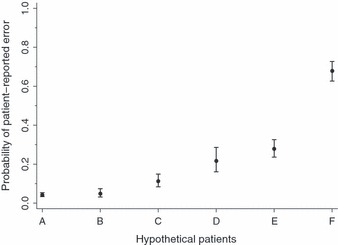Figure 2.

Predicted probability for patient‐reported error (aggregate measure) across 11 countries for six hypothetical patients (A–F), weighted data. Six hypothetical patients (A–F) were modelled with the following characteristics: Patient A: Aged >65 years, average income, good self‐reported health, two or more chronic conditions, emergency care, no hospital or surgery, two or more prescription drugs, one or two doctors, no specialist, no coordination of care problems. Patient B: Aged <65 years, much below average income, poor self‐reported health, no chronic conditions, no emergency care, hospital stay and surgery, no prescription drugs, no doctors seen, no specialist, no coordination of care problems. Patient C: Aged <65 years, average income, poor self‐reported health, one chronic condition, no emergency care, hospital stay, no surgery, one prescription drug, one or two doctors, specialist, no coordination of care problems. Patient D: Aged >65 years, much below average income, poor self‐reported health, no chronic conditions, emergency care, hospital stay and surgery, no prescription drugs, one or two doctors, no specialist, poor coordination of care. Patient E: Aged <65 years, average income, good self‐reported health, one chronic condition, no emergency care, no hospital stay or surgery, two or more prescription drugs, three or more doctors, specialist, poor coordination of care. Patient F: Aged <65 years, much below average income, poor self‐reported health, two or more chronic conditions, emergency care, hospital stay and surgery, two or more prescription drugs, three or more doctors, specialist, poor coordination of care.
